I’m thinking of buying a treadmill. My work requires long hours on a computer, and evidence shows that sitting for long periods, as I do in front of a computer, does no favours for my health. Sitting causes not just muscle weakness, it contributes to Type 2 diabetes, heart and circulation conditions, and even some cancers.
I’m not the only person who spends hours and hours on the computer or at a desk in order to bring home the tofu — or hours and hours lying on the sofa watching Netflix on weekend evenings. Some estimates peg the global cost of our privileged, sedentary lifestyles at more than $86 billion a year.
Research shows that moving our bodies regularly is essential to keeping us in the pink of health. Some studies show that exercise also helps keep our minds sharp and the creative juices flowing. Our distant ancestors lived as hunter-gatherers — if they wanted to eat, they had to be active, and that requirement lingers in our DNA. However, other than those who work on farms, on the sea or in the forest or who are professional athletes, we rarely are that active these days.
Just small amounts of exercise make a difference. One recent study of middle-aged and older adults found that swapping out just one half-hour of sitting with physical activity every day cut risk of early death by up to 35 per cent.
Even standing, which requires the body to engage leg and core muscles, helps.
With 40 per cent of 1,000 Canadians aged 25-64 years admitting to Ipsos researchers last year that they get less than 30 minutes of daily physical activity and a similar number saying they don’t have time to exercise, finding ways to integrate movement and exercise into existing routines has become a critical First World challenge. If we can fit exercise into our work habits and processes, all the better.
A growing body of research suggests using an active workstation might help. For example, in a trial of sit-stand desks over 12 months, researchers found workers spent one hour less sitting each day, on average, and reported improved job performance.
So, I’m looking at various models of treadmills to use with my current desk while I work. I’m also looking at under-desk stationary bikes, steppers and even a less-wobbly version of a balance board — anything compact and steady enough that fits in the limited space available, gets me moving and allows me to work.
When researchers in Montreal analyzed studies comparing how using treadmill, cycling and standing workstations variously affected muscles, heart rate, blood pressure, energy use, cognitive performance at work, as well as processing speeds, attention and short-term memory, they found benefits and costs to each.
Each workstation type yielded a short-term boost in productivity. The researchers also found that the cycling and treadmill versions seem to lead to greater and more positive short-term fitness and cognitive improvements than the standing versions. Both treadmill and cycling workstations boosted heart rate and energy use and decreased blood pressure during the working day compared with standing workstations. They also increased alertness and reduced boredom more than standing versions did.
In the treadmills’ favour, walking workstations were linked to lower stress scores, got people moving more and increased upper-body muscular activity more than did other versions. However, the upper body effort needed to stabilize gait and posture on a treadmill workstation seemed to interfere with the fine motor skills needed for keyboarding.
Cycling workstations, on the other hand, improved simple processing speeds the most.
And the 12-month trial of sit-stand desks mentioned earlier? Workers needed coaching, sitting and standing targets, and feedback on their physical activity to get those results.
Few of us work on farms, fields and forests for a living anymore. The only hunting and pecking we do these day is on a keyboard, but the legacy of our ancestors’ active hunting and gathering ways remains. To be healthy, our bodies — not just our fingers and our minds — must work hard and regularly throughout each day.



